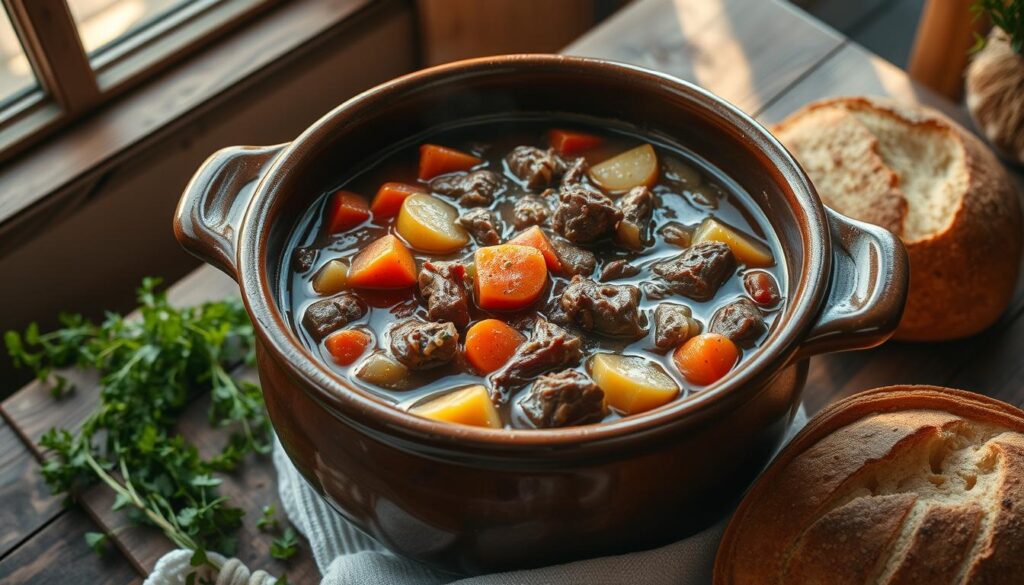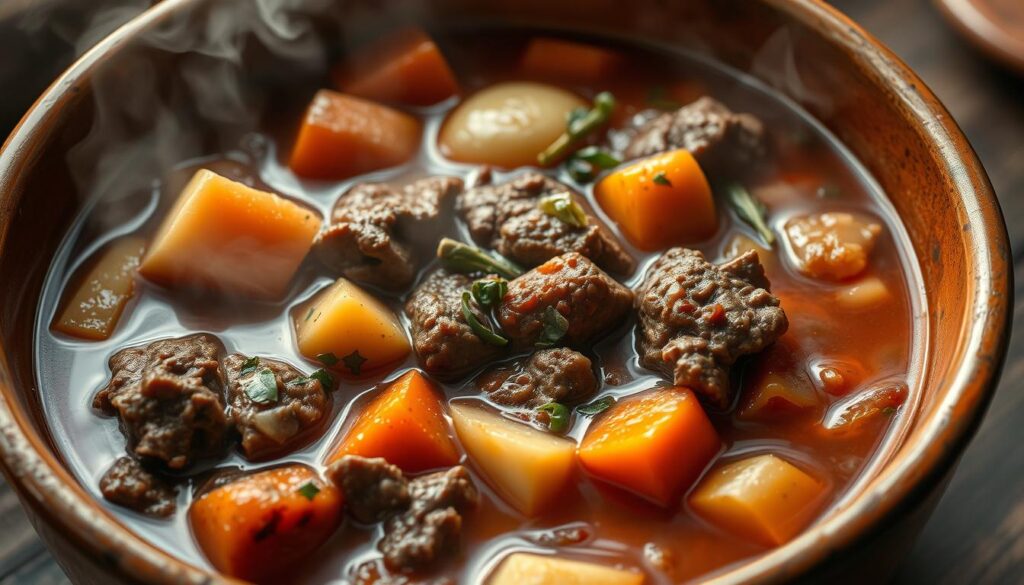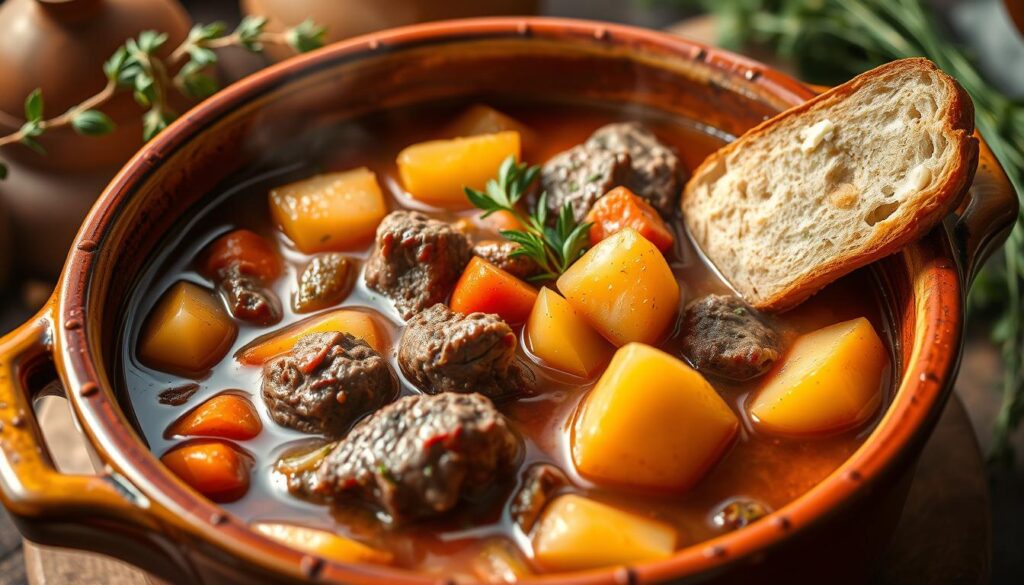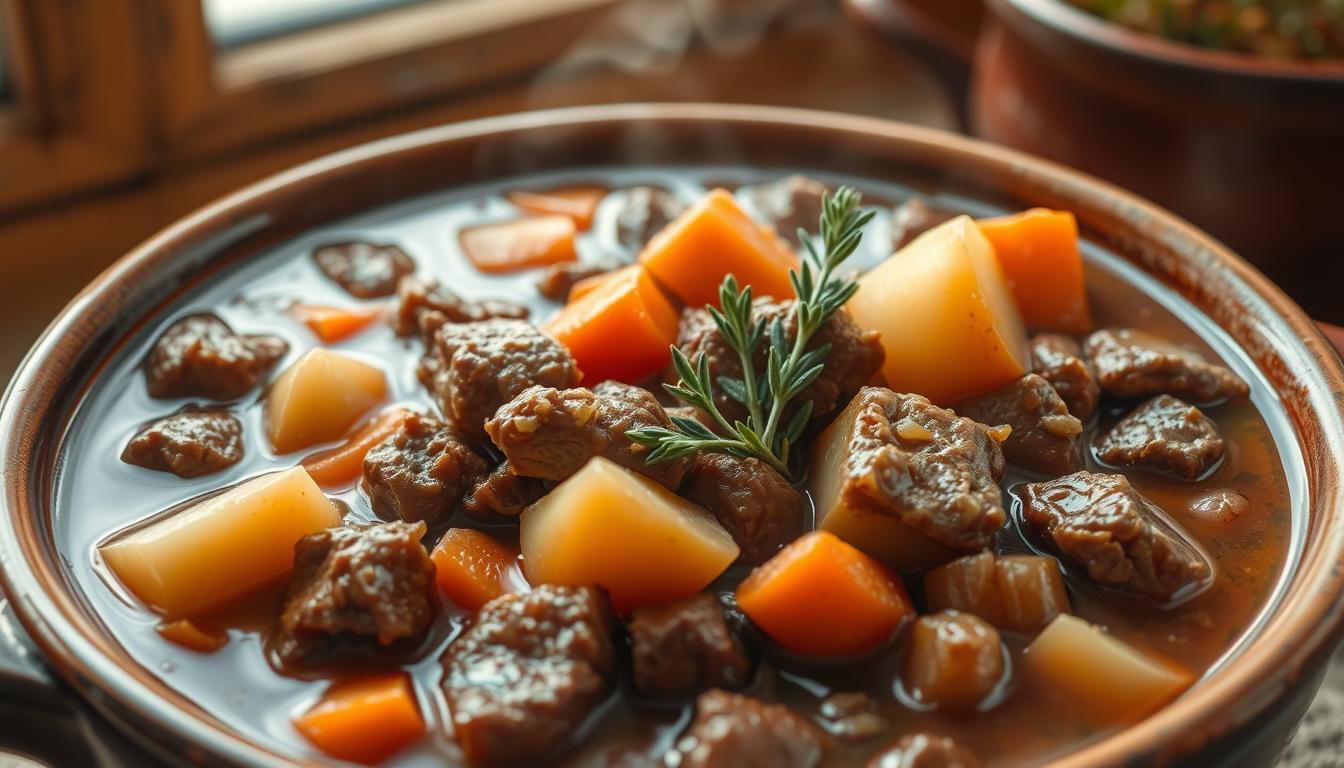Delicious Beef Stew Recipe You’ll Love
When it gets cold, nothing warms you up like a hearty bowl of stew. This classic French dish is perfect for cozying up in your kitchen.
This hearty dish is cooked slowly in a rich broth. It makes the meat tender and full of flavor. It’s the ideal meal for a cold night, and it’s simple to prepare.
Picture yourself snuggled up with a warm bowl of comfort food. It’s sure to make you feel cozy and content.
Table of Contents
The Rich History of Beef Stew
Beef stew has a long history, starting with ancient cooking methods. It has become a favorite dish around the world. Many cultures have made it a staple, using different ingredients and cooking ways.
Origins Around the World
Beef stew’s history is rich and varied. It started in different places. In Europe, it was a dish for peasants, made with tough meat cooked over an open fire.
In other cultures, similar stews were made with local ingredients. This shows how diverse its origins are.
Evolution of the Classic American Beef Stew
The American beef stew reflects the country’s diverse culture. It grew from European roots, adding local tastes and ingredients. Now, it’s a comforting dish for any time, and learning how to make beef stew is rewarding.
It offers a hearty beef stew recipe that’s both filling and tasty.
Why Beef Stew Is the Ultimate Comfort Food
Beef stew is more than a meal; it’s a soul-warming experience. It has been a comfort food favorite for many years. It offers a easy beef stew recipe that suits many tastes.
Nutritional Benefits
A good beef stew is comforting and nutritious. It has tender beef, various veggies, and grains. This makes it a balanced meal. The one-pot beef stew method keeps all flavors and nutrients in, making it a healthy choice.
- High-quality protein from beef
- Vitamins and minerals from a variety of vegetables
- Complex carbohydrates for sustained energy
Versatility for Any Season
Beef stew is versatile. It’s perfect for a cold winter night or a nourishing dish in cooler months. It’s also great for a slow cooker beef stew. This way, you can prepare it in the morning and enjoy it when you get home.

Essential Ingredients for the Perfect Beef Stew Recipe
The secret to a great homemade beef stew is in its ingredients. A good stew combines flavors and textures for a cozy meal.
Choosing the Right Cut of Beef
Choosing the right beef is key for a tender stew. Boneless beef chuck is top choice for its flavor and softness when slow-cooked.
Best Affordable Cuts
On a tight budget? Chuck roast or round are great. They’re tasty and won’t break the bank.
Premium Options for Special Occasions
For a fancy stew, try beef short ribs or filet mignon. They make your stew feel like a special treat.
Fresh Vegetables That Make a Difference
Fresh veggies bring out the stew’s best. Carrots, potatoes, and onions are classics. Try parsnips or mushrooms for something new.
| Vegetable | Preparation Tip | Flavor Contribution |
|---|---|---|
| Carrots | Slice into uniform rounds | Sweetness and crunch |
| Potatoes | Cut into large chunks | Hearty, comforting texture |
| Onions | Sauté until caramelized | Depth of flavor and sweetness |
Herbs and Seasonings for Maximum Flavor
The right herbs and seasonings make a stew stand out. Use thyme, rosemary, and bay leaves for a rich taste. Remember to add salt and pepper to taste.
Kitchen Equipment You’ll Need
The right kitchen tools are key to making a delicious beef stew. Whether you’re an expert or just starting, having the right equipment is important. It makes cooking a success.
Pot Options: Dutch Oven vs. Slow Cooker vs. Pressure Cooker
You have a few pot choices for cooking your beef stew. A Dutch oven is great for slow cooking on the stovetop or in the oven. It cooks evenly. A slow cooker is perfect for cooking without much effort, letting you cook for hours. If you’re in a hurry, a pressure cooker can cook your stew fast while keeping flavors.
- Dutch Oven: Ideal for stovetop and oven cooking.
- Slow Cooker: Perfect for hands-off, long-duration cooking.
- Pressure Cooker: Great for reducing cooking time.
Essential Tools for Preparation
You’ll also need some basic tools to get your ingredients ready. A sharp knife is essential for cutting the beef and veggies. A cutting board gives you a clean space to work. Don’t forget measuring cups and spoons to get the right amounts of herbs and seasonings.
- Sharp Knife: For cutting beef and vegetables.
- Cutting Board: Provides a clean preparation surface.
- Measuring Cups and Spoons: Essential for accurate seasoning.
Preparation Steps Before Cooking
The secret to a rich and flavorful beef stew is in the preparation. Before cooking, follow key steps to make your homemade beef stew perfect.
Properly Cutting and Preparing the Beef
Start by removing large chunks of fat that are easy to access. But don’t trim too much, as fat makes the beef tender. Cut the beef into uniform pieces for even cooking. For a hearty beef stew recipe, choose tougher cuts like chuck or brisket. They become tender with slow cooking.
Vegetable Preparation Techniques
Chop vegetables based on their cooking time. Cut harder veggies like carrots into larger pieces. Softer veggies, like potatoes, can be cut into smaller chunks. This ensures all veggies are cooked just right. The secret to how to make beef stew is balancing cooking times.
Creating a Flavor Base
A good flavor base is key for a rich stew. Start by sautéing your veggies and aromatics to enhance their flavors.
The Importance of Mirepoix
Mirepoix, a mix of onions, carrots, and celery, is essential in French dishes like beef stew. It adds depth and complexity. Sauté mirepoix in oil until it’s softened and fragrant.
Building Depth with Tomato Paste and Worcestershire
Tomato paste and Worcestershire sauce boost the umami flavor, making your stew richer. Tomato paste adds a strong tomato taste. Worcestershire sauce adds a tangy, savory element.
The Best Beef Stew Recipe Step-by-Step
To make a memorable beef stew, follow key steps. These steps make this comfort food unforgettable. The process requires careful preparation and detail, but it’s worth it.
Browning the Meat Perfectly
Browning the meat is crucial for a rich beef stew recipe. Heat oil in a Dutch oven or large pot over medium-high. Add beef in batches, avoiding overcrowding. Brown on all sides, which takes time but adds depth.
As chef Julia Child said, “The only time to eat diet food is while you’re waiting for the steak to cook.”
“Brown, not bland, is the motto of a good cook.”

Building Layers of Flavor
After browning the meat, start building flavor layers. Sauté onions, garlic, and aromatics until softened and fragrant. Then, add vegetables like carrots, potatoes, and celery. Cook until they start to soften.
Simmering to Perfection
Now, let the stew simmer. Bring it to a boil, then lower the heat to low. Let it cook, covered, until meat is tender and vegetables are done. This slow cooking melds flavors and makes meat tender.
How to Know When Your Stew Is Done
How do you know when your stew is ready? Check the meat and vegetables for tenderness. They should be fork-pierced easily. Taste and adjust seasoning if needed. When it’s perfect, serve and enjoy.
Variations to Try with Your Beef Stew
Mastering the basic beef stew recipe is just the start. Now, it’s time to get creative with exciting variations. You can turn your easy beef stew recipe into a new culinary adventure by adding different ingredients and flavors.
Want to mix things up? Try swapping potatoes for turnips or parsnips, which are lower in carbs. Many root vegetables can work well in this recipe, so don’t be afraid to experiment.
Wine-Infused Beef Stew
Adding a cup of red wine to your one-pot beef stew can enhance the flavor. The wine adds a richness that complements the beef perfectly. Just add the wine along with your beef broth for a stew that will wow your guests.
Hearty Beef and Guinness Stew
For a twist, try using Guinness stout in your stew. The dark, malty flavor of Guinness pairs well with beef, making a hearty slow cooker beef stew. Just remember to reduce the broth amount to balance the liquid.
Mediterranean-Style Beef Stew
To add a Mediterranean twist, include Kalamata olives, artichoke hearts, and sun-dried tomatoes. These ingredients will take your taste buds on a trip to the Mediterranean, offering a refreshing twist from traditional flavors.
These variations show how versatile your beef stew recipe can be. Whether you crave something rich and wine-infused or hearty and Guinness-based, there’s a version for every taste.
Slow Cooker and Instant Pot Adaptations
Adapting your beef stew recipe to a slow cooker or Instant Pot makes cooking easier. These methods require little supervision. This means you can enjoy a tasty, homemade meal without much effort.
Slow Cooker Beef Stew Method
Using a slow cooker for beef stew is easy. Start by searing the meat in a skillet. Then, add the cooked meat and veggies to the slow cooker. Pour in the broth and add spices, but hold off on the flour.
Prep-Ahead Tips
Prep your ingredients a day early. Chop the veggies and marinate the beef in the fridge overnight. This saves time and boosts flavor.
Timing Guidelines
Cook the stew on low for 8-10 hours or high for 4-6 hours. The slow cooking tenderizes the meat and blends the flavors.
Instant Pot Beef Stew in Under an Hour
The Instant Pot cuts cooking time in half without losing flavor. Brown the meat in the pot’s sauté function. Then, add the rest and cook under high pressure for about 30 minutes.

For a quick easy beef stew recipe, just follow the steps. Adjust cooking time for tender meat. You’ll get a one-pot beef stew that’s both filling and delicious.
Serving Suggestions and Pairings
The best beef stew recipe deserves delicious pairings for a complete meal. Serving your stew with the right sides can make the dining experience better.
Best Sides to Accompany Your Stew
Choosing the right sides can enhance your beef stew’s flavors. Here are some popular options:
- Crusty bread for dipping into the rich broth
- Mashed potatoes for a hearty, comforting meal
- Egg noodles for a classic combination
Bread Options
Artisan bread or popovers are great for soaking up your beef stew recipe‘s sauce. Consider serving with:
- Crusty baguette slices
- Warm, buttery dinner rolls
- Garlic bread for an added flavor boost
Complementary Salads
A fresh salad can contrast nicely with the warm stew. Try pairing with:
- A simple green salad with light vinaigrette
- Roasted vegetable salad for added depth
- Caesar salad for a tangy, savory option
Wine and Beverage Pairings
The right drink can make your classic beef stew recipe even better. Consider pairing with:
- A rich, full-bodied red wine like Cabernet Sauvignon
- A warm, spiced cider for a seasonal touch
- Dark beer, such as Guinness, for a robust flavor
Storing and Reheating Your Beef Stew
Your delicious homemade beef stew can be enjoyed for days with the right storage and reheating. Whether it’s a large batch from a slow cooker or a simple recipe, proper storage is key. It keeps the flavor and ensures safety.
Refrigeration Tips
Let your stew cool a bit before refrigerating it. It can stay in the fridge for up to 3 days. To reheat, use the stovetop on medium-low heat, stirring now and then, until it’s hot.
You can also reheat it in the microwave, covered, on a lower power setting. This prevents overheating.
Freezing for Later Enjoyment
To freeze your beef stew, cool it completely and put it in an airtight container. Freezing helps keep the flavors and texture. When you’re ready to eat it again, thaw it in the fridge overnight.
Troubleshooting Common Beef Stew Problems
Beef stew can sometimes go wrong, even with a great recipe. Issues like tough meat, wrong thickness, or flavor imbalances can happen. Luckily, most problems have simple fixes.
Fixing Tough Meat Issues
Tough meat often comes from not cooking it enough or using the wrong cut. Choose a chuck roast with good marbling for tender meat. Make sure to slice against the grain if you’re not using pre-sliced chunks. Cooking the stew on low heat for a longer period also tenderizes the meat.
Adjusting Thickness and Flavor
If your stew is too thin, thicken it with a cornstarch or flour mix. For a thicker stew, add broth or water. To adjust flavors, taste and add herbs and seasonings as needed. A balanced stew comes from layering flavors.
| Issue | Solution |
|---|---|
| Tough Meat | Use a tender cut, cook longer on low heat |
| Too Thin | Add cornstarch or flour mixture |
| Too Thick | Add broth or water |
Rescuing an Oversalted or Bland Stew
To fix an oversalted stew, add a potato or a bit of sugar. For a bland stew, add more herbs, spices, or vinegar. It’s easier to add more seasoning than to fix an oversalted stew.
Conclusion
Now you’ve learned about the rich history and benefits of beef stew. This classic dish is more than a meal. It’s a comforting, hearty dish that warms your home and delights your taste buds.
Our guide taught you how to choose the right beef and prepare fresh veggies. You also learned how to layer flavors. Whether you use a Dutch oven, slow cooker, or Instant Pot, our recipe is easy to adapt.
Enjoying your beef stew is not just for today. It can be stored and reheated later. So, try our recipe and enjoy a home-cooked meal that will become a family favorite.







